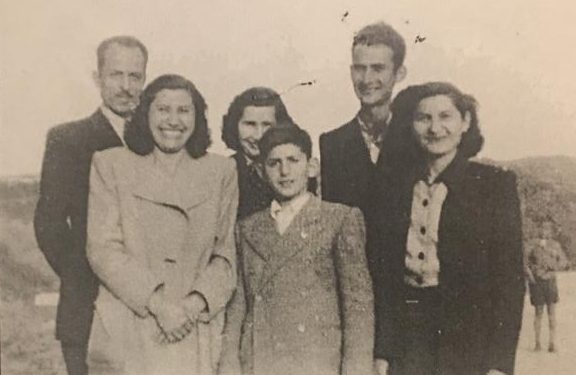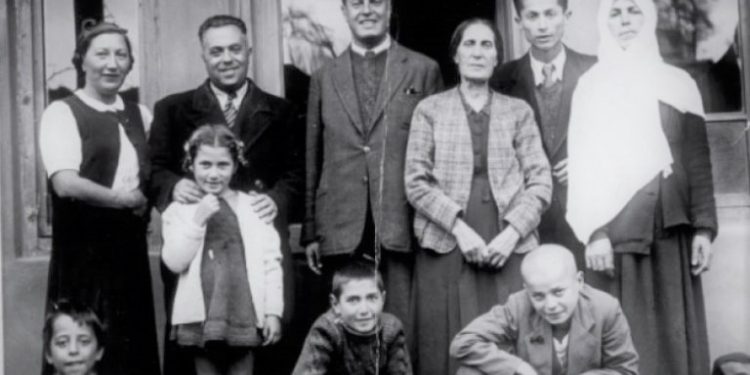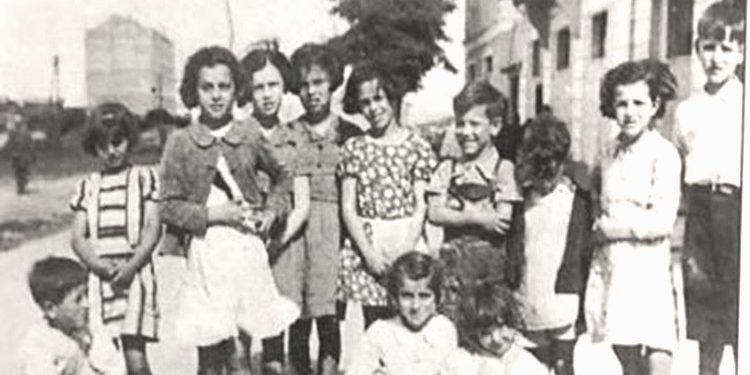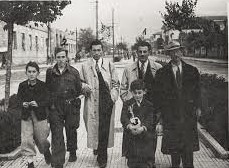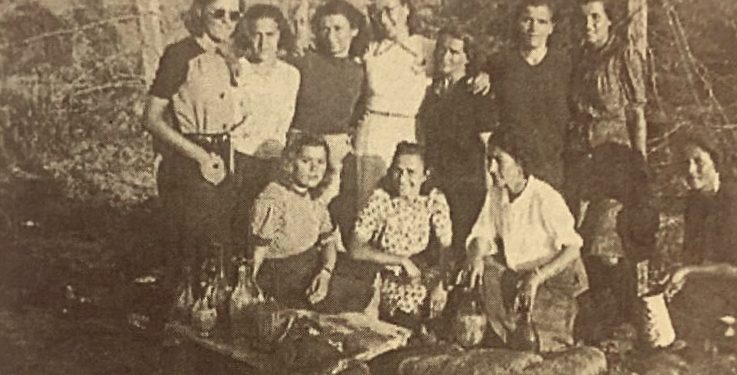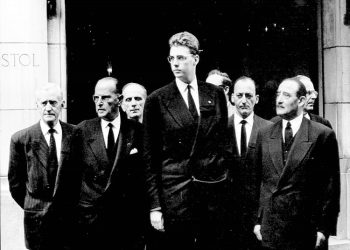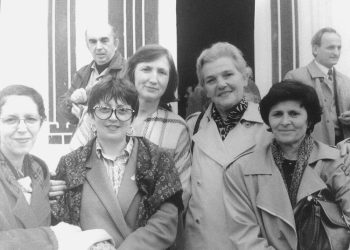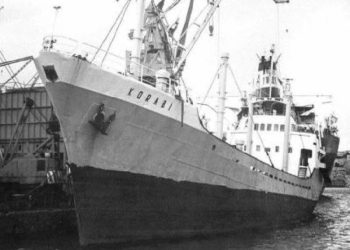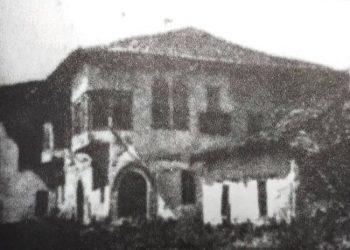By Sulo GOZHINA
Memorie.al / Whenever January 27 approaches each year, the mind goes to the day of the Holocaust, to World War II, the victims of which were 6 million, of whom only Jews were counted. Unlike other countries, Albania offered shelter and protection for the Jews. During the war, over 600 individuals, including men, women, and children, came to Berat. Writing about this people, both as much as they have suffered and as noble as they are, takes a lot of time, work, effort, and sweat. The broad scope of this topic shows that every time you sit down to research, just as many new details and previously unpublished stories emerge each time. A topic of this kind has been addressed in the last two decades by the well-known publicist and researcher from Berat, Simon Vrusho. For his valuable work to date, as well as for new discoveries in this field, we conducted this interview.
Mr. Vrusho, over the last 20 years, you have written and published extensively about the Jewish presence in Berat—books, articles, studies, reports, portraits, etc. In several writings and interviews on this interesting yet vital topic for the Jews, almost from the medieval period to the time before and after World War II and beyond, references have been made to you. But even when it seems that this topic has been exhausted or depleted, you still, unexpectedly, bring forth, discover, and publish new facts, documents, and details. My question is: what has been the latest discovery regarding this topic?
The latest is Miki, Miki, a Jew with trays in hand, sheltered during the Holocaust in Berat (1942-‘45) at the family of Vangjel Buda, among the Budas, a generation of jewelers, likely of Jewish descent, distinguished jewelers also known for icon work in engraving, casting, and embellishment…! Vangjeli died young, in 1968, at 50 years old…! Devoted to jewelry, books, and the “Voice of America”…! He died with the “Voice of America” at his ear…!
He passed his profession of jewelry to his son Dhimitri (Taqo), who has passed it down to his sons, Gavril and Valirian…! Miki was kept like a house son until 1945, when Vangjel Buda escorted him to Durrës, where other Jews had gathered, returning to the countries they had emigrated from…! Nasho Qytyku, 81 years old, a neighbor of the Budas, remembers Miki, as they were the same age and played together in the streets of “Vakëfi”…!
It seems that the number of Jewish tourists, Israelis, is increasing in the city of Berat. They are interested in the presence of their ancestors in this city, the traces, the testimonies, the echoes?
When they hear or see that the Jews had a neighborhood of their own, a neighborhood located in the center of Berat, from an urban perspective (between the Lead Mosque and the Metropolitan Church), where the street is named “JEWS,” and when they learn that the Jewish community had its rights recognized and protected, when they had representatives in the city administration, when they had their synagogue, they surely feel good…!
But they were not in the center only from an urban point of view, but also economically and financially, as their community or trade Jews financed and supported the local economy during difficult times…!
They were also at the center from a cultural aspect, as their representatives actively participated in literary contests and competitions organized in the city, where the local elite would take part…! From the beginning of the 1500s, the Jewish neighborhood had 11 families, and after a few decades, it grew to 25 families and later reached 100 families…!
Their traces can be found everywhere, in Bilçë or Duhanas, with meaningful toponyms, etc. Thus, there is a historical presence, an uninterrupted Jewish component over the centuries, and naturally, the peak is reached with the shelter and rescue of over 600 Jews during the Holocaust…! Yes, this is a chapter in itself, widely addressed already, although there is still room for exploration…!
This shelter, this rescue, shows what Berat was for the Jews; therefore, it seems that Berat itself tells Jewish tourists, visitors, and researchers: “Jews, Berat is your city too!” Go to the Xhezo family and find a box, a testimony of the stay and shelter of the Jews, “a golden box,” where on one side the Star of David is engraved and on the other side, a synagogue (see photos from that period), Jewish women and children in courses for learning the Albanian language in Berat, while many others, Jewish children, registered and continued the school year 1942-’43, alongside Berat children, as in the case of the mixed school “Kastrioti,” a school in the center of Berat, which attests that life went on, and education continued…!
You can also find this in Jacqueline Silver’s study book “…AND THEY STILL LEARN,” “Education of Jewish Children in Nazi Occupied Areas Between 1933-1945.”
Both Albania and Berat are part of that area where Jewish children learned in a school, in a classroom, sitting on a bench with Albanian children…! And there they sat, Jewish children and Albanian children, even sharing a bench with the son of aspirant Myrto Qafa (an effective member of the gendarmerie in Berat), Ermir Qafa, etc.
In the register of the mixed school “Kastrioti” in Berat, for the school year 1942-’43, there were also two Jewish students registered and promoted to the second grade: the first, Juso Ruben (registration number 1490), born in Prishtina in 1933, residing in the “Uzgur” neighborhood of Berat, and the second, Vili Albahar (registration number 1491), born in Belgrade on December 18, 1934.
Their parents, Mihal Ruben and Danilo Albahar, were categorized as immigrants. Surely, in the schools of Berat during those years, there were dozens of Jewish students with original or changed names. From this perspective, the attention and the thousands of dollars funding that the Israeli embassy in Tirana, ambassador David Cohen, provides for children’s daycare centers in Berat, 70 years later, seems quite natural…!
You dedicated your book “THE JEWS OF BERAT” to Dr. Zino Matathia?!
Yes, Dr. Zino Matathia, “Honorable Citizen” of Berat, to whom I dedicated the book “The Jews of Berat,” published in 2010. In 1971, he also operated on my father at the hospital in Berat. He was a doctor on the staff of the Israeli military hospital, which was stationed in the camp of Kosovo refugees in Macedonia in 1999.
Since 1991, he has lived in the city of Karmiel, Israel, where he has been honored as a “Distinguished Citizen.” Almost every year, he visits Albania, including Tirana, Vlorë, and Berat. He worked as a doctor for 14 years, serving as the director of the hospital in Berat.
In July 2017, a delegation from the Municipality of Karmiel, Israel, led by the mayor, Adi Eldar, visited the Municipality of Berat. What was the novelty brought by the delegation to Berat?
The visit was organized within the framework of the twinning connections between the two cities, Berat and Karmiel. In the meeting held with representatives of the Municipality of Berat on July 19, the possibilities for cooperation between the two cities were discussed, mainly in cultural exchanges, education, agribusiness, and increasing capacities among the staff.
Present at the meeting were also the ambassador of Israel in Albania, Boaz Rodkin, and the Honorary Consul of Albania in Israel, Menashe Getz. During their stay in Berat, the Karmiel delegation also visited the Historical Center of Berat, the Castle, and the Iconographic Museum “Onufri,” as well as the “Caterina Firenze” shoe business.
Part of the agenda included visits to the administrative units of Roshnik and Sinjë, which are important areas for the development of agribusiness, primarily in the production of olives, cherries, vineyards, etc.
The delegation also held several meetings with the staff of the Municipality of Berat and the Cultural Center, the Arts Gallery, and the Public Library, where they discussed the possibilities for joint projects and cultural exchanges.
At the end of the visit, a meeting was organized between the respective mayors and staffs, where the conclusions of the visit were presented, and the markers for cooperation on concrete projects were established…!
Lastly, a few lines about the decorated vessels with the “Star of David” found in a family in Kostrën of Tomorr?
In fact, such decorated vessels where the “Star of David” is at their center, which for me are centuries old, are numerous in our areas and this shows the friendship we have had with the Jews over the centuries and that we still continue to maintain fervently to this day.
If we return to the history of World War II, it is no coincidence that Albanians defended the lives of Jews, risking their own lives, and this is most evident in Berat, where the Jews in our city during the war were sheltered in several neighborhoods, which is why we say with full conviction that Berat is also their city.*/Memorie.al
***
Berat families that sheltered Jews during World War II
- Isuf Qojle
- Qani Civeja
- Mehmet Xhezo
- Halil Frashëri
- Xhevat Gjergjani
- Xhevahir Zaganjori (Shkodrani)
- Vexhi Buharaja
- Hysen Nallbani
- Bari Zeko
- Burhan Ruli
- Sulo Muzhaka
- Tajfur Haznedari
- Asaf Xhufi
- Gani Telegrafi
- Sulo Droboniku
- Tefik Ruzi
- Taq Simsia
- Lilo Xhimitiku
- Jorgji Naço
- Irakli Meroli
- Gaq Kajana
- Dhimiter Shyti
- Llazar Shollla
- Toli Dodi
- Dhoksi Speci
- Siku Gjogu
- Kozma Gega
- Llukan Gjika
- Tasi Bixhonja
- Vangjel Sota
- Zoi Vesho
- Grigor & Peçi Shkurti
- Jorgji Angjeliu
- Resmie Spathara
- Ndon Papai
- Miti Cania
- Vlash Myzeqari
- Hiqmet Çipi





